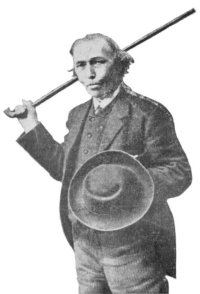 Fans Honor ‘World’s Worst Poet’
Fans Honor ‘World’s Worst Poet’
by Ben McConville
Edinburgh, Scotland (AP) — The land that gave the world Robert Burns also has the dubious honor of producing the “world’s worst poet.” Now fans of the hapless William McGonagall are campaigning to put him in the pantheon of Scottish literary greats.
The late 19th century poet’s work is so bad he carried an umbrella with him at all times as protection from the barrage of rotten tomatoes he faced wherever he recited.
His most famous work, a poem initially titled “The Railway Bridge of the Silvery Tay,” drew derision from crowds when it required a hasty rewrite after the structure collapsed in 1879.
It became “The Tay Bridge Disaster” with the immortal opening stanza: “Beautiful Railway Bridge of the Silv’ry Tay!/Alas! I am very sorry to say/That ninety lives have been taken away/On the last Sabbath day of 1879/Which will be remember’d for a very long time.”
More than 100 years after the poet’s death, detractors still won’t give him a break: The Scottish literary establishment has blocked plans for a memorial to him at the Writers Museum in Edinburgh alongside those honoring Robert Burns, Robert Louis Stevenson, and Sir Walter Scott.
“The decision to turn down a place for McGonagall was just snobbery pure and simple,” said Bob Watt, chairman of the Edinburgh Friends of William McGonagall.
“These academics and arts big wigs don’t like McGonagall because he’s so accessible – he’s the peoples’ poet. To me he is one of the greats of Scottish literature. … He endures to this day because he touches the lives of so many people. He’s about laughter, some folk laugh at him while others laugh with him.”
Despite his plodding verse and excruciating rhymes, McGonagall has remained in print since his death in 1902. He was branded the “world’s worst” by his own publisher who put the epithet on a volume of his works.
McGonagall himself was confident of his genius, believing his poetry to be second only to that of Shakespeare. “>Read the rest of the story here.
Image from scotstext.org
